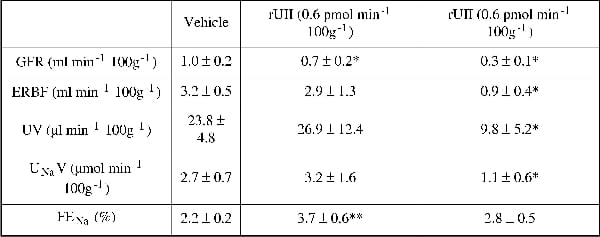Urotensin II (UII) is an 11-amino acid vasoactive peptide which has been identified as the ligand for the human orphan G protein-coupled receptor GPR-14, now designated the UT receptor. UII has been shown to stimulate epithelial sodium transport in fish [1] and there is now evidence that it also affects renal function in mammals. Recently, we have shown that bolus injections of rat UII (rUII) into the anaesthetised rat produced dose-related reductions in glomerular filtration rate (GFR), urine flow rate and sodium excretion [2]. The aim of the current study was to determine the effect of a continuous infusion of rUII on renal function in the rat. Anaesthetised (Intraval, 100 mg/kg, i.p.) male Sprague Dawley rats (n=7 per group) were infused with 0.154M saline (containing 3H inulin as a marker of GFR and para-aminohippuric acid as a marker of effective renal plasma flow, ERBF) via a jugular vein catheter for 4 hours at 50 µl/min. Animals were then divided into three groups which received either vehicle, rUII at 0.6 or 6 pmol min-1 (100g body weight)-1 for 1 hour. The infusate was then switched back to saline for a further hour. Urine samples were taken every 15 min via a bladder catheter; blood samples were taken once per hour via a carotid artery catheter for the measurement of electrolyte concentrations. All measured variables were in a steady state and did not differ between groups prior to the infusion of rUII; mean arterial pressure was unaltered throughout. Compared with the vehicle-infused group, rUII at 0.6 and 6 pmol min-1 (100g body weight)-1 caused significant (P<0.05) dose-related decreases in glomerular filtration rate (GFR), which reached a maximum 45 min after the start of infusion (Table 1). rUII at 6 pmol min-1 (100g body weight)-1 also induced significant (P<0.05) reductions in effective renal blood flow (ERBF), urine flow (UV) and urinary sodium excretion rate (UNaV). Fractional excretion of sodium (FENa) was increased (P<0.01) during infusion of rUII at 0.6 but not 6 pmol min-1 (100g body weight)-1. Urinary K+, Ca2+ and Mg2+ clearance and excretion rates also fell during rUII infusion at 6 pmol min-1 (100g body weight)-1. These data suggest that rUII, at the doses employed in this study, influenced renal function by reducing GFR and hence the filtered load of ions. The pronounced haemodynamic effect of rUII may mask an additional tubular action, as FENa was increased at the lower dose of rUII employed. This is consistent with our previous observation that the UT receptor is expressed in the loop of Henle and inner medullary collecting ducts [2].
University College London 2006 (2006) Proc Physiol Soc 3, PC13
Poster Communications: Effect of urotensin II infusion on renal function in the anaesthetised rat
Alaa ES Abdel-Razik1, Richard J Balment1, Nick Ashton1
1. Faculty of Life Sciences, University of Manchester, Manchester, United Kingdom.
View other abstracts by:
Table 1. Renal variables after 45 mins i.v. infusion of rUII at either 0.6 or 6 pmol min-1 (100g body weight)-1
Where applicable, experiments conform with Society ethical requirements.

